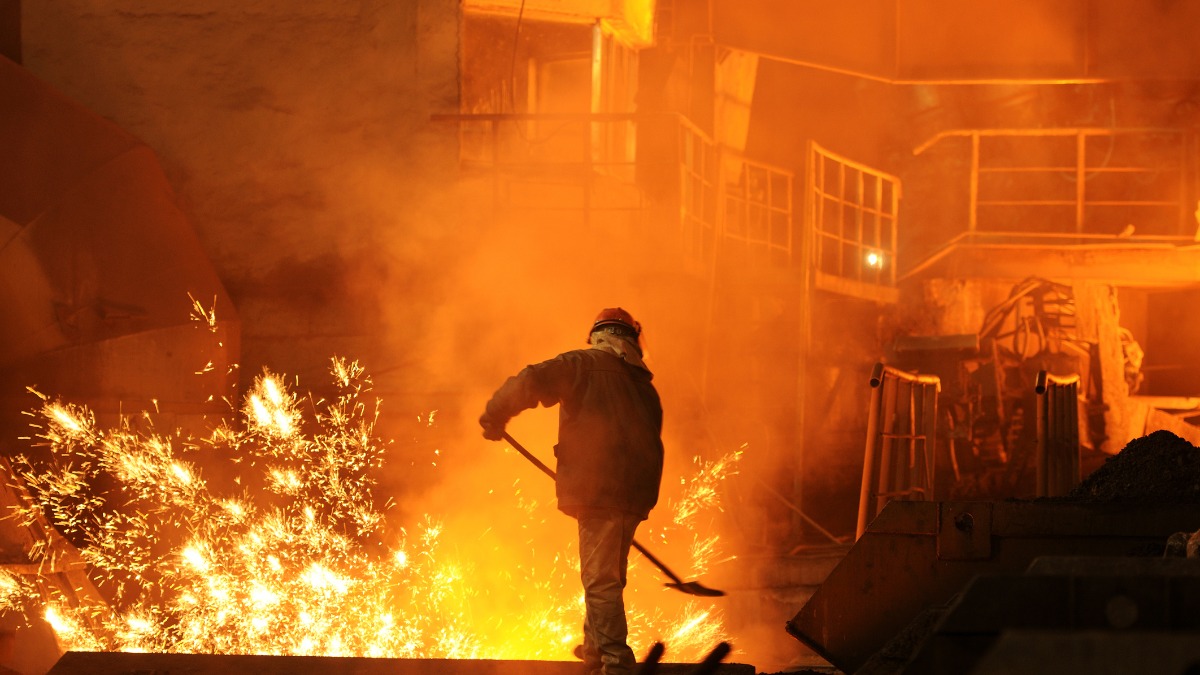BHP confident steel customers will be able to use carbon capture to reduce emissions from blast furnaces
The world’s biggest miner is hopeful its Pilbara ores can also be used in greener DRI-ESF steelmaking processes
China ramps up imports of coking coal, including from Australia, but it’s not all it’s cracked up to be
BHP (ASX:BHP) has expressed confidence carbon abatement initiatives from blast furnace steel mills can develop to “achieve, and well exceed” the company’s 30% 2030 emissions reduction target.
It comes with the company also hopeful its mid-grade ore can be used in direct reduced iron plants, technology that generates a fraction of the emissions of a blast furnace to produce a tonne of steel and could theoretically run with hydrogen but normally requires ultra high-grade, low-impurity ore to be viable.
The inability to use Pilbara ores, the most bountiful source of iron units in the world, has long been a handbrake on the expansion of DRI steel production.
That is especially the case in China, producer of almost 60% of the world’s crude steel, which is also limited in its ability to expand electric arc furnace production because of its need to import scrap steel due to the young nature of its finished steel products.
Speaking to investors, analysts and media on a decarbonisation briefing yesterday, BHP’s head of decarbonisation partnerships Dr Nigel Tame insisted the company and its steelmaking customers in Asia were making strides to reduce emissions in an industry responsible for 8% of the world’s total CO2 pollution.
It’s especially sensitive for BHP, which has a 2050 Net Zero target and 30% reduction target for FY2030 for its operational Scope 1 and 2 emissions, but is only saying it is “pursuing the long-term goal of net zero Scope 3 emissions by CY2050, despite its uncertainty and the extent of the challenge”.
The vast bulk of BHP’s emissions profile is related to these Scope 3 emissions, those generated by its customers, largely steel factories.
At its mines in the Pilbara BHP anticipates rolling out 500MW of wind, solar and battery storage backed by ‘firm power’ from its Yarnima gas-fired power station, while its Chilean copper assets are already on a 100% renewable power load.
And BHP’s vice president of climate Dr Graham Winkelman said “if technology develops as we think it can”, the miner will roll out its first electric truck fleet in FY2028 and electric locos from FY2030. With trolley assist technology, currently being studied for the Escondida and Spence copper mines in Chile, battery electric trucks could outperform diesel vehicles uphill, according to BHP VP of operational decarbonisation Dan Heal.
Steel is a trickier proposition.
Commercial deployment
BHP says carbon capture can help reduce steel emissions from the blast furnace pathway, a critical innovation if steel emissions are to reduce over time given the high penetration of BF and BOF mills in China and India’s steel producing mix.
Both are at a relatively young age, meaning most plants won’t be replaced for decades, though Chinese authorities have pushed capacity swaps in recent years to replace older mills with greener alternatives.
“For the blast furnace route on the left hand side, we aim to demonstrate the potential for reductions in CO2 emissions intensity at scale through trials or pilots of developing technology, such as carbon capture,” Tame said.
“The steel industry regards carbon capture, utilisation and storage, or CCUS, as a critical abatement option for existing blast furnaces, and 9 out of 10 of the largest steel producers with net zero goals include CCUS in their roadmaps.
“For the blast furnace, we believe that emissions reduction options can be combined to achieve, and well exceed, the 30% emissions intensity reduction capability of our CY2030 goal, and head towards near zero.”
CCUS is a technology with a chequered history, at least in Australia, where Chevron’s failure to meet design rates for storage at its Gorgon Gas Project has been a persistent talking point.
However, BHP itself is taking the lead on the “DRI-Electric Smelting Furnace” route, where it is short on material that can fit the specs of current DRI plants.
“Our objective is to establish and optimise the performance of our ores in the raw material preparation and DRI steps, and we are well on the way. For example, we are seeing growing use of our ores in pelletising in China, and we recently commenced DRI production trials with two customers also in China,” Tame said.
“The next step in this process is the electric smelting furnace step (or ESF). To optimise this step, we need a deeper understanding of how DRI feed materials, based on our Pilbara ores, interact with ESF operational parameters to produce iron at the quality and productivity needed for downstream steel.
“The pairing of direct reduced iron with an electric smelting furnace has deep emissions intensity reduction potential – around 80% relative to the conventional blast furnace route today.
“The ESF is very flexible compared to other process routes, as it can accept a wide variety of iron ore grades and can potentially produce a wide variety of steel grades like a blast furnace does now.”
BHP has three projects on the go to support feasibility work on an electric smelting furnace pilot, including a PFS on a plant in a partnership with peer and competitor Rio Tinto (ASX:RIO) and Aussie steelmaker Bluescope Steel (ASX:BSL) due in FY2025 ahead of a potential pilot facility launch in 2027.
Iron ore rebounds
Iron ore futures meanwhile rebounded yesterday, running 3.6% higher in Singapore to US$107.05/t despite some bearish Chinese property data that cast a pall over commodities like steel and copper.
Prices have been largely bound in a range of US$100-110/t in recent weeks after enthusiasm sparked by hopes of stronger Chinese stimulus earlier this year began to wane.
The commodity opened the year at more than US$140/t, with the flagged closure of the Mineral Resources (ASX:MIN) Yilgarn iron ore operations despite ~$300 million of WA Government royalty relief from 2018 to 2023 placing a question mark over marginal smaller producers.
There remain some willing to bet on the small scale iron ore projects largely scuttled in the violent aftermath of the 2021 boom, when prices rose to US$237/t and crashed within six months to just US$87/t, hurting low-scale high-cost players.
Gold Valley, a Perth-based privately owned miner chaired by Chinese-born businessman Yuzheng Xie, has cobbled together a number of those assets in a bid to gain a foothold in the sector.
They include the remote Wiluna West Iron Ore Project, acquired from GWR Group (ASX:GWR) in 2022, where Gold Valley has flagged increasing exports to 3Mtpa through the ports of Esperance and Geraldton by the end of 2024, as well as a right to mine the Ullaring hematite project near Menzies owned by Macarthur Minerals (ASX:MIO).
A third forgotten asset was vended into the Gold Valley portfolio on Monday, with Venture Minerals (ASX:VMS) announcing a $3m sale of its ill-fated Riley mine.
VMS was forced to shut Riley in September 2021 immediately after completing its first shipment as prices crashed.
But as spot prices rebounded last year VMS took another look before engaging Argonaut PCF in a sales process.
ASX iron ore stocks
Scroll or swipe to reveal table. Click headings to sort.
CODE COMPANY PRICE WEEK RETURN % MONTH RETURN % 6 MONTH RETURN % YEAR RETURN % MARKET CAP ACS Accent Resources NL 0.007 0% 0% -13% -36% $ 3,311,890.98 ADY Admiralty Resources. 0.01 11% 0% 43% 25% $ 14,665,265.46 AKO Akora Resources 0.15 0% -6% 1% -2% $ 18,073,106.40 BCK Brockman Mining Ltd 0.018 -22% -18% -25% -44% $ 167,044,178.36 BHP BHP Group Limited 43.34 1% -3% -13% -2% $ 219,698,714,992.44 CIA Champion Iron Ltd 6.4 -2% -14% -18% 6% $ 3,310,665,396.39 CZR CZR Resources Ltd 0.285 -5% -7% 50% 46% $ 67,184,374.11 DRE Dreadnought Resources Ltd 0.02 -26% 18% -35% -62% $ 70,261,459.20 EFE Eastern Resources 0.0055 -8% -21% -31% -45% $ 6,830,705.54 CUF Cufe Ltd 0.013 -7% 0% -13% -7% $ 17,356,460.75 FEX Fenix Resources Ltd 0.315 -2% -2% 21% 26% $ 218,804,644.80 FMG Fortescue Ltd 21.63 -1% -19% -24% 1% $ 66,721,169,773.06 RHK Red Hawk Mining Ltd 0.87 -1% 1% 38% 113% $ 173,835,986.73 GEN Genmin 0.105 0% -25% -34% -13% $ 71,949,090.78 GRR Grange Resources. 0.37 10% -9% -15% -24% $ 416,641,931.28 GWR GWR Group Ltd 0.086 -1% -9% -5% 34% $ 27,624,632.33 HAV Havilah Resources 0.19 6% -10% -5% -17% $ 60,161,449.90 HAW Hawthorn Resources 0.059 -8% -13% -40% -59% $ 19,765,921.17 HIO Hawsons Iron Ltd 0.027 -4% -13% -40% -31% $ 27,240,991.47 IRD Iron Road Ltd 0.079 -4% -17% 13% 0% $ 64,905,717.55 JNO Juno 0.036 3% -28% -64% -55% $ 6,550,029.36 LCY Legacy Iron Ore 0.013 -7% -13% -19% -38% $ 100,276,127.41 MAG Magmatic Resrce Ltd 0.057 -5% -33% 16% -27% $ 23,771,890.70 MDX Mindax Limited 0.047 -2% 52% -6% -22% $ 96,292,837.66 MGT Magnetite Mines 0.275 -16% -29% -3% -31% $ 27,069,539.20 MGU Magnum Mining & Exp 0.015 -6% 7% -48% -35% $ 12,140,421.05 MGX Mount Gibson Iron 0.41 0% -10% -23% -5% $ 498,102,330.53 MIN Mineral Resources. 56.57 -7% -25% -17% -19% $ 10,957,448,787.60 MIO Macarthur Minerals 0.06 0% -15% -57% -68% $ 10,323,707.28 PFE Panteraminerals 0.033 10% -33% -37% -65% $ 11,938,884.14 PLG Pearlgullironlimited 0.017 -23% -26% -45% -39% $ 3,477,210.43 RHI Red Hill Minerals 6.5 -3% -4% 33% 39% $ 415,653,582.50 RIO Rio Tinto Limited 120.97 1% -9% -10% 7% $ 45,084,209,190.30 RLC Reedy Lagoon Corp. 0.003 0% -25% -40% -38% $ 1,858,622.20 CTN Catalina Resources 0.003 0% -25% -25% 0% $ 3,715,460.68 SRK Strike Resources 0.038 6% -12% -22% -32% $ 10,782,500.00 SRN Surefire Rescs NL 0.008 0% -16% -11% -43% $ 15,890,462.50 TI1 Tombador Iron 0.014 0% 0% 0% -30% $ 30,218,753.22 TLM Talisman Mining 0.255 -2% -27% 19% 55% $ 48,021,689.00 VMS Venture Minerals 0.022 -19% -8% 214% 57% $ 49,866,953.44 EQN Equinoxresources 0.325 -20% -18% 10% 171% $ 40,137,500.98 AMD Arrow Minerals 0.0025 -17% -38% -38% -17% $ 26,348,412.74 CTM Centaurus Metals Ltd 0.425 -9% -10% -9% -51% $ 210,876,784.75
China invites more Aussie coal
New stats show China has lifted imports of Australian coking coal by 226% this year, in a minor revival of the trade once described by BHP’s chief economist Huw McKay as the sun around which the solar system of the met coal market orbited.
An unofficial ban ended early last year after more than two years on ice, thanks to tensions between Australian and China over the Covid outbreak.
China has been buying up coking coal imports in large volumes of late, up 44% YoY to 9.7Mt in May. While Mongolian and US imports have been up this year so far by 30% and 37%, it’s the rapid lift in Aussie imports that stands out.
But the devil is in the detail. Australian coal miners have found alternative markets, especially in India, while China has becoming wedded to Mongolian and Russian met coal, with Aussie coal only accounting for 6% of China’s met coal imports in the first five months of 2024, Commonwealth Bank analyst Vivek Dhar noted.
Since the ban ended, Australia’s thermal coal grades have made up a larger share of its sales into China.
“That compares with a~41% share in 2019 – prior to China’s unofficial ban on Australian coal. It’s hard to see how Australia’s share in China’s coking coal imports returns to levels before China’s unofficial ban on Australian coal,” he said.
“Mongolia and Russia have stepped up to claim a larger structural share of China’s coking coal imports. From January to May, Mongolia and Russia accounted for ~51% and ~25% of China’s coking coal imports respectively – up from ~45% and ~7% in 2019.
“The Ukraine war has been instrumental in driving Russia’s growing share in China’s coking coal imports following western sanctions on Russian coal.”
Coking coal prices are currently sitting at around US$239/t, with Commbank forecasting average prices for premium Aussie met coal of US$200-250/t ‘for the foreseeable future’.
Dhar believes China’s coking coal import demand has come less from steel sector demand, with crude steel production down 1.4% to May, and more from a decline in domestic production due to shutdowns following mining fatalities.
Thermal coal futures were trading at US$133.50/t yesterday, with prices largely in a holding pattern for much of the year.
ASX coal stocks
Scroll or swipe to reveal table. Click headings to sort.
CODE COMPANY PRICE WEEK RETURN % MONTH RETURN % 6 MONTH RETURN % YEAR RETURN % MARKET CAP NAE New Age Exploration 0.003 -25% -25% -50% -40% $ 5,381,696.73 CKA Cokal Ltd 0.092 -4% -2% -23% -16% $ 99,263,306.16 BCB Bowen Coal Limited 0.053 -12% -32% -47% -65% $ 150,944,291.39 SVG Savannah Goldfields 0.015 -25% -57% -66% -85% $ 4,216,273.74 GRX Greenx Metals Ltd 0.895 -4% 1% -4% -20% $ 249,616,423.64 AKM Aspire Mining Ltd 0.36 3% 64% 260% 429% $ 182,749,314.60 AVM Advance Metals Ltd 0.025 4% 0% -32% -81% $ 3,385,311.08 YAL Yancoal Aust Ltd 6.29 5% 1% 29% 42% $ 8,305,564,058.73 NHC New Hope Corporation 4.86 5% -2% -6% -1% $ 4,049,156,872.56 TIG Tigers Realm Coal 0.003 0% 0% -40% -40% $ 39,200,107.10 SMR Stanmore Resources 3.49 5% 6% -10% 36% $ 3,172,898,551.68 WHC Whitehaven Coal 7.62 -1% -1% 2% 16% $ 6,441,826,036.80 BRL Bathurst Res Ltd. 0.815 2% -3% -16% -9% $ 155,958,220.70 CRN Coronado Global Res 1.165 -1% 2% -31% -23% $ 2,003,362,207.35 JAL Jameson Resources 0.036 0% 16% -20% -41% $ 18,095,372.51 TER Terracom Ltd 0.205 3% -7% -47% -49% $ 160,193,247.00 ATU Atrum Coal Ltd 0.004526 0% 0% 0% 0% $ 11,966,853.96 MCM Mc Mining Ltd 0.15 -3% -3% 3% 11% $ 62,102,002.35 DBI Dalrymple Bay 2.96 1% 0% 10% 11% $ 1,447,624,067.64 AQC Auspaccoal Ltd 0.075 7% -14% -25% -41% $ 40,035,069.30
At Stockhead, we tell it like it is. While Venture Minerals was a Stockhead advertiser at the time of writing, it did not sponsor this article.
The post Bulk Buys: BHP hopeful steel market can cut emissions appeared first on Stockhead.






















